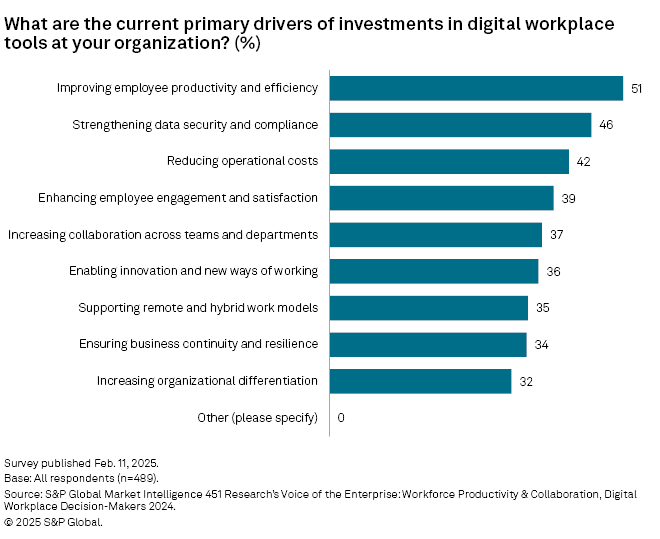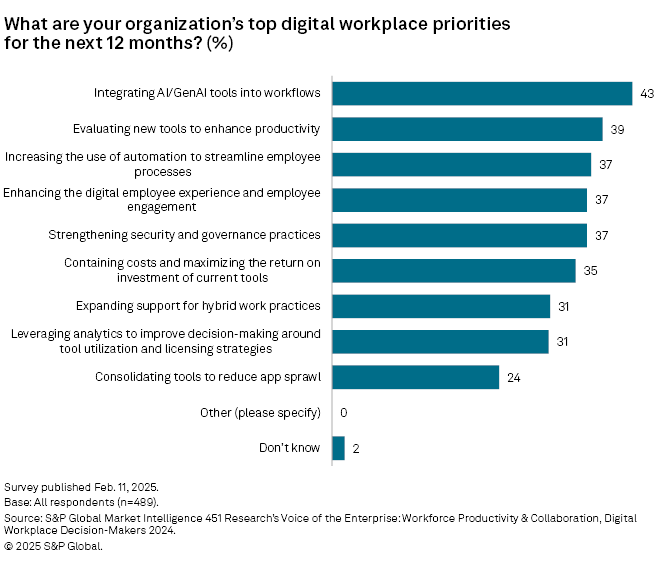Featured Topics
Featured Products
Events
S&P Global Offerings
Featured Topics
Featured Products
Events
S&P Global Offerings
Featured Topics
Featured Products
Events
S&P Global Offerings
Featured Topics
Featured Products
Events
Financial and Market intelligence
Fundamental & Alternative Datasets
Government & Defense
Banking & Capital Markets
Economy & Finance
Energy Transition & Sustainability
Technology & Innovation
Podcasts & Newsletters
Financial and Market intelligence
Fundamental & Alternative Datasets
Government & Defense
Banking & Capital Markets
Economy & Finance
Energy Transition & Sustainability
Technology & Innovation
Podcasts & Newsletters
Research — May 28, 2025

By Sarah James

| As AI rolls out, companies are still figuring out how to best engage employees post-pandemic. Source: vm/E+ via Getty Images |
Five years ago, COVID changed the way people work. Now, AI is poised to do the same.
The pandemic catalyzed companies and their employees to embrace remote and hybrid work — a change that now seems permanent. This shift, coupled with post-pandemic fluctuations in the labor market, has challenged traditional strategies around employee engagement. The result is sometimes costly losses in productivity. Gallup Inc.'s latest State of the Global Workplace report, published at the end of April, estimates that a 2-percentage-point drop in employee engagement in 2024 cost the world economy $438 billion in lost work.
Given the steep cost of productivity losses associated with lower engagement, companies are looking at how technological advancements — and AI in particular — might help. Improving employee productivity and efficiency was the top driver of digital workplace investments among enterprises, cited by more than half of respondents, according to a survey conducted at the end of 2024 by S&P Global Market Intelligence's 451 Research.
But experts warn that technology alone is not enough. For technology to succeed at driving workforce efficiency, employee adoption is critical, and that goes back to the human problem of engagement.
"Having new technological tools plus an engaged workforce is always going to be best," said Matthew Bidwell, a professor of management at the University of Pennsylvania's Wharton School. With previous technological advancements, Bidwell noted that the companies that saw the biggest benefits were the ones that focused on how to make the best use of their workforce when the technology was implemented. "I suspect it's going to be the same with AI," he said.

Benefits of AI
In terms of driving productivity, one major area of focus is in what is called employee service, according to Chris Marsh, who manages both the Workforce Productivity & Collaboration and Data, AI & Analytics practice areas within 451 Research. Similar to traditional customer service, employee service aims to make people's work lives easier to navigate.
In particular, Marsh sees companies like Zendesk Inc. and Salesforce Inc. using AI to help with "busy work," or the work employees do that is not outcome-focused.
"Before you even get down to doing the work, there's work to think about, 'How do I find documents? Who should I be collaborating with?'" Marsh said. Other examples he gave included submitting time sheets, time off requests or expense reimbursements.
"There's a big engagement issue because it's so frustrating doing all this stuff," he said.
The benefits of employee service AI applications are immediately apparent to workers, which is likely to aid in adoption, said Stan Phelps, author of the "Goldfish" series of books that aims to teach companies to create differentiated experiences for employees and customers.
"A lot of aspects of people's jobs that they absolutely hated or were time-consuming, AI can really power those things and alleviate a lot of that burden to hopefully free up the time for employees to focus in areas where they truly can make impact or where they get the most value," Phelps said.
Improving an employee's day-to-day technology experience can not only free up a person's time but also aid in retention, Marsh said, noting this is especially true following the post-pandemic digitization of work.
"People will leave the company and go somewhere else if they're not having a good technology experience," Marsh said. "About one-third of employees say, 'I would actually leave and go to another company if they could guarantee me a better experience.' That never used to be the case 15 years ago."
Upskilling vs. AI outsourcing
Employee service is just one of many use cases for AI, and enterprises of all sorts are experimenting with the technology.
When asked about their top digital workplace priorities for the next 12 months, 43.4% of respondents in 451 Research's "Voice of the Enterprise: Workforce Productivity & Collaboration, Digital Workplace Decision-Makers 2024" survey selected integrating GenAI tools into workflows. Second on the list, at 39.1%, was evaluating new tools to enhance productivity.

To prepare for the new technology tools, many companies are considering how to upskill their workforce.
"A huge focus right now at the C-suite level is around skilling — upskilling and reskilling," Marsh said. Executives want to become more agile at redeploying skills or upskilling workers given the time and expense of recruiting. At the same time, employees want opportunities to grow their skillsets and become more employable in the labor market.
Some experts warn, though, that as more employees learn to use AI, fewer employees will be needed.
"Some CEOs say that AI will not replace workers, but people who know how to use AI will replace other people [who do not,]" said Mark Ma, associate professor of business administration at the University of Pittsburgh's Katz Graduate School of Business. "The implied statement that these CEOs do not say is that they will need to hire fewer people who know how to use AI to replace more workers who do not know that."
Ma expects "huge changes to the workplace in the next decade or two due to the development of AI and robotics," with job losses in sectors that involve repetitive tasks.
Others, though, say the outlook for job displacement due to AI is still murky.
"You can believe anything about technology and about what AI is going to do; I probably believe seven different things every day," Bidwell said. The Wharton professor sees employees and employers grappling with "an interesting tension" in regards to adopting AI.
"You want your employees to be figuring out and making the best of it, but employees are also legitimately worried that it's coming for all of their jobs," he said. "Some companies are doing more than others to try and reassure people, but it's hard to reassure them when I think there will be cases in some places where we just need fewer people."
Rules of engagement
Good engagement and strong management can help to solve the problem of getting employees to embrace new technology.
Engaged employees — defined as those who understand their role, feel their work is important and feel rewarded for a job well done — are more likely to put in discretionary effort or go above and beyond their current job, said Jim Harter, Gallup's chief workplace scientist.
Engaged employees are also more likely to adopt new technologies like AI.
"They'd be a lot more open-minded to anything that makes their performance improve and makes their job more innovative and efficient than it's been in the past," Harter said. By comparison, less engaged work cultures and employees would "more likely to think of AI as more like a threat than an opportunity."
As enterprises invest in technologies to drive productivity, Harter said they must also continue investing in their people. Thinking about how AI could drive employee engagement rather than drive employees out will be critical for organizations and their workers.
"Engagement is really the human nature of work," Harter said. "We've got to think about how we make sure our needs as a human being are met, regardless of what our current situation is."
This article was published by S&P Global Market Intelligence and not by S&P Global Ratings, which is a separately managed division of S&P Global.
451 Research is a technology research group within S&P Global Market Intelligence. For more about the group, please refer to the 451 Research overview and contact page.